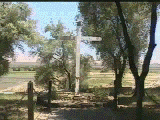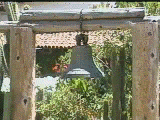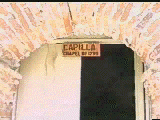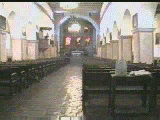Mission
San Juan Bautista
was founded on
Saturday, June 24, 1797 by Father Fermin de Lasuen, Presidente of the
California Missions, a post he held after the death of Father
Junipero Serra. It was the 15th mission in the 21 mission chain in
Alta California. It was named for Saint John the Baptist. The mission
church is said to be the largest of the missions and held 1,000
people during the mission days. The dimensions are 188 feet long and
72 feet wide and is the only mission with 3 aisles, two on the sides
and one down the center of the church.
Back
to the top
Local Indians
 Click
here to see a video of the Mission cemetery
Click
here to see a video of the Mission cemetery
The
cemetery is an olive
grove behind the
church. There are more than 4,000 Indians buried in the mission
cemetery which is located right on the San Andreas earthquake fault.
In the distance you can see present day farmers working the crops in
the Central Valley of California just as the mission Indians once
worked.
The
Indians of the
Mission San Juan Bautista
area were part of the Ohlone Tribe. They were friendly and came to
help build the mission, work in the fields and take care of the
cattle. The Indians built all of the buildings and did nearly all of
the work on the mission. The Indians at this mission liked the
lifestyle so much that they needed to enlarge the church to hold
1,000 people.
Back
to the top
Economy of the mission
The
economy at Mission
San Juan Bautista was
similar to the other missions in that they planted crops of wheat and
corn. They also planted vineyards, and raised cattle and sheep. The
agriculture was needed not only to maintain the mission community and
the nearby Indians, but was used for trade and served to visitors to
the mission. A thriving trading center for tides, tallow and farm
products, sprung up around the mission.
Back
to the top
The
community
 Click here
to
see a video Inside the Mission Quadrangle
Click here
to
see a video Inside the Mission Quadrangle
The
town of San Juan
Bautista grew up around
the mission. Barracks for soldiers, a nunnery, the Castro House and
other buildings were constructed around a large grassy plaza in front
of the church and can be seen today in their original form. The town
of San Juan Bautista grew rapidly during the Gold Rush and continues
to be a thriving community today.
Back
to the top
Secularization
After
Mexico won its
independence from
Spain, it found that it could no longer afford to keep the missions
running as Spain had done. In 1834, Mexico decided to end the mission
system and sell all of the lands. They offered the lands to the
Indians who did not want the lands or could not come up with the
purchase price. The lands were divided into smaller Ranchos and sold
to Mexican citizens who were helpful during the war for independence.
After nearly 30 years, the missions were returned to the Catholic
Church. Although some of the missions had already been returned to
the church, in 1863, President Abraham Lincoln signed an Act
declaring that all of the 21 missions in the California mission chain
would become the property of the Catholic Church and have remained so
since that time.
Back
to the top
Rebirth
Mission
San Juan Bautista
has served mass
daily since 1797, so there never was much of a rebirth. The mission
was restored in once 1884, and again, in 1949 the mission was
restored and was financed by the Hearst foundation.
Back
to the top
Current use
 Click
here
to see a video Inside the Mission Chapel
Click
here
to see a video Inside the Mission Chapel
Mission
San Juan Bautista
is still active to
this day and claims to have served mass every day since 1797. The
mission is still used as a parish church and continues be active in
the community.
Back
to the top
Graphic tour
 Click
below
to see a video Inside the Mission Church
Back
to the top
Click
below
to see a video Inside the Mission Church
Back
to the top
Assessment
Mission
Quiz
Objective:
answer 7 questions correctly. JavaScript
required!
1.
Who was the founder of
Mission San Juan Bautista?
Junipero
Serra
Gaspar
de Portola
Fermin
Lasuen
Sebastian
Vizcaino
2. Mission San
Juan Bautista was founded....?
June 24,
1797
September
21, 1769
April
21, 1782
June 14,
1804
3. Mission San
Juan Bautista is the only mission
with...?
a tile
roof
a
3-aisle church
priests
buried under the altar
field
trips
4. Mission San
Juan Bautista is know as...?
the
smallest of the missions
the
largest of the missions
the
oldest of the missions
the
coolest of the missions
5. Who did the
actual building of the missions?
construction
companies
the
priests
the
soldiers
the
local Indians
6. What happened
to the missions in 1834?
They
opened
The
Indians took over
Secularization
nothing
7. Mission San
Juan Bautista claims to...?
have an
organ in the church
be the
richest of the missions
have
served mass every day since
1797
have a
bell tower
8. Mission San
Juan Bautista is named after...?
Father
Serra
Father
Lasuen
St. John
the Baptist
the King
of Spain
9. What happened
in 1833?
An
earthquake
Secularization
Father
Serra died
the
Mission was taken over by Mexican
priests
10. What did
Abraham Lincoln agree to in 1863?
Formally
return the Mission lands to
the Church
Run for
President of the United
States
Visit
the San Antonio de Padua
Mission
force
the Indians to leave the
Mission
Back
to the top
The
Mission
Page | The
Assessment Page
|Main Page
Other San Juan Bautista
sites:
California
Mission Internet Trail
The
Spanish Missions of California
California
Missions
San
Juan Bautista
- Click on Indian
Family Housing at Mission San Juan Bautista and Gallery of photos and
drawings. Report of archaeological work on State of California Parks
property near the mission church. Text by state archaeologist Glenn
Farris.
This project written by Rob
Garretson in
partial fulfilment of
the Master's
of Arts Degree
from Cal
Poly
Pomona
Please
send questions
and/or comments to Mr.
Garretson
This
page last updated on February 28, 2015